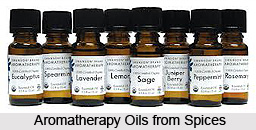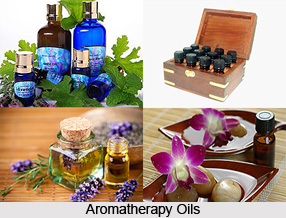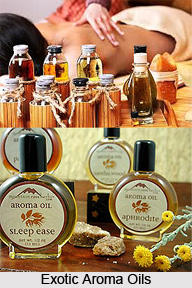 Aromatherapy Essential oils are the aromatic and volatile constituents found in plants. These constituents contain the essence of all the active properties of that plant. Chemically, essential oils are made up of Alcohols, Aldehydes, Ketones, Phenols, Terpenes, Sesquiterpenes, Ethers and Esters. In the living plant, these aromatherapy essential oil components are used as hormones for growth and reproduction, plant pheromones for smells, which will attract pollinating insects, defense mechanisms protecting the plant from predators (herbivores and insects) and also protection against bacterial, viral, or fungal invasion. Aroma oils or Essential oils are subtle, volatile liquids that are extracted from plants, shrubs, flowers, trees, bushes, herbs, spices, woods and fibers, usually by distillation, expression and solvent extraction. Essential oils can be derived from all parts of the plant, which are given as follows:
Aromatherapy Essential oils are the aromatic and volatile constituents found in plants. These constituents contain the essence of all the active properties of that plant. Chemically, essential oils are made up of Alcohols, Aldehydes, Ketones, Phenols, Terpenes, Sesquiterpenes, Ethers and Esters. In the living plant, these aromatherapy essential oil components are used as hormones for growth and reproduction, plant pheromones for smells, which will attract pollinating insects, defense mechanisms protecting the plant from predators (herbivores and insects) and also protection against bacterial, viral, or fungal invasion. Aroma oils or Essential oils are subtle, volatile liquids that are extracted from plants, shrubs, flowers, trees, bushes, herbs, spices, woods and fibers, usually by distillation, expression and solvent extraction. Essential oils can be derived from all parts of the plant, which are given as follows:
a) Flowers produce Aromatherapy oils that often have sedating, narcotic or relaxing effects on the body.
b) The Resins, Woods, Barks and Exudates produce heating aromatherapy oils that actively move fluids in the body.
c) The Leaves often have healing and cooling properties coming from the green color of chlorophyll (very closely related to our hemoglobin structure).
d) The Roots contain many of the earth properties of the plants and can be very grounding.
e) The Fruits produce essential oils that are very expanding, opening and stimulating.
Care and Selection of Aromatherapy Oils
Like any other medicinal application, a proper use of Aromatherapy Oils is therapeutic, while an improper use may be extremely toxic and harmful. There are many oils that cannot be taken internally or some that should not be taken during pregnancy. And apart from certain "mild" oils, direct application on skin, or even direct inhalation should be avoided. Although care and precaution for all oils are different, there are certain general precautions that we can follow to avoid any disaster. These are:
1. Aromatherapy oils are light and sensitive, hence they should be stored in tightly capped amber or colored bottles away from extremes of heat or cold. Anything being sold in a clear bottle is most likely not an essential oil. Clear glass, at the very least, can indicate distribution by people unfamiliar with essential oils.
2. Aromatherapy oils should be labeled with the botanical name of the extracted plant and information should be available about the method used to produce them.
3. Aromatherapy oils vary greatly in price due to production variables. It can take up to 2,000 pounds of rose petals to produce one pound of rose aromatherapy oils through distillation. 25 pounds of citrus rind make one pound of expressed citrus oils. Due to the variables of labor, rainfall, farming costs, extraction methods and demand on the world market, Rose oil tend to be costlier than orange oil. If you see different essential oils selling for the same price, it is probable that these oils are diluted with vegetable oil to create this pricing structure.
4. Beware of fragrances usually sold in clear glass. These are not aromatherapy oils, but are chemical compositions made in a laboratory to produce a smell, which is a copy of nature. One should also make sure that there is no such aromatherapy oil as watermelon, bubble gum or Pina colada.
 5. In general, the most useful oils are those that mix well with as many other oils as possible. They also need to have the broadest range of therapeutic uses combined with the most pleasant aromas possible. Some of these oils are Jasmine, Lavender, Neroli, Peppermint, Rose and Sandalwood. Some more useful extra oils are Chamomile, Eucalyptus, geranium, lemon, patchouli and Ylang Ylang.
5. In general, the most useful oils are those that mix well with as many other oils as possible. They also need to have the broadest range of therapeutic uses combined with the most pleasant aromas possible. Some of these oils are Jasmine, Lavender, Neroli, Peppermint, Rose and Sandalwood. Some more useful extra oils are Chamomile, Eucalyptus, geranium, lemon, patchouli and Ylang Ylang.
Aromatherapy Oils and Our body
There are multiple ways through which essential oils can interact with our body. The first stage of absorption is through the skin layer. The aromatherapy oil penetrates the epithelial tissues; these include the skin, nasal passages, bronchioles, lungs and gastro-intestinal tract.
The second stage comprises of penetrating to inner tissues of the body. The penetration of aromatherapy oils into skin is 400 times faster than that of the water. Once absorbed into the surface layer, essential oils quickly penetrate into the lymphatic and blood capillary systems, entering into the general circulation. The same happens to the other epithelial tissues of the body, including sinuses and lungs. The aromatherapy oils in the lymph circulatory system can be carried directly to the liver or fed into the blood stream. As the oils circulate with the blood, body tissues and organs may choose any portion of the aromatherapy oil that it wishes to utilize in its metabolic processes, or simply receive the stimulation, sedation, or beneficial property of the oil as it passes through. It is important to remember that nothing stays in the body very long. Aromatherapy oils, because of their volatile nature, usually leave the body within 48 hours.
The third stage involves the elimination process. Some components of aromatherapy oils are picked up by the surface of the lungs and are exhaled as vapors. Eucalyptol (an alcohol in eucalyptus oil) is transported to the lung surfaces by the blood stream and calms the mucous membranes as it exits. Others, such as the Terpene in Juniper berry oil, are filtered out by the kidneys, and have a stimulating effect on the renal tissue, uterus, bladder and urethra as they exit. Some components of the essential oils are extracted by the liver, held briefly in the gall bladder, and dumped into the intestinal tract, having profound affects on these organ systems as they pass through. Rose oil stimulates bile production as the liver processes it.
Some constituents tend to exit via the sebaceous glands and become part of the protective acid mantle (coating). Components of yarrow increase perspiration as they are excreted. Soap damages the skin because its alkalinity removes the acid mantle. The essential oils that move through this pathway are added to our protective layer. But the basic essence of aromatherapy essential oils lies in smell. When we smell essential oils, the vapor stimulates small hair-like extensions of our olfactory nerve. The olfactory nerve is the only nerve in the body that directly contacts the external environment and goes all the way to the brain.
All of our other senses (touch, rearing, sight, and taste) involve several nerves and synaptic junctions before the impulses reach the brain. The olfactory nerve stimulates the most primitive part of the brain known as the limbic system, also called the saurian or reptilian brain. This is important in the processing of and reaction to emotions, desires, appetites and memories. This direct connection is the reason why aroma oils have such deep and forceful impact on our moods and overall "being". Even small dose is enough to create the sensations. Large doses are generally discouraged. The following is a list of general therapeutic properties and their meanings. The general therapeutic properties of Aromatherapy oils are as follows:
1. Alterative - Ability to clean and purify blood, alter the nutritive and excretory process to restore normal health.
2. Antipyretic - Dispels heat, fire and fever (from the Greek word pyre -fire).
3. Antispasmodic - Relieves spasms of voluntary and involuntary muscles.
4. Aphrodisiac - Reinvigorates sexuality and overall spirit of the body.
5. Astringent - Reduces discharges and secretions: firms tissue and organs.
6. Bitter Tonic - Bitter herbs, which in small amounts stimulate digestion and otherwise help regulate fire in the body.
7. Carminative - Inducing the expulsion of gas from the stomach and intestines.
8. Diaphoretic - causes perspiration and increased elimination through the skin.
 9. Diuretic - promotes activity of kidney and bladder and increases urination.
9. Diuretic - promotes activity of kidney and bladder and increases urination.
10. Emetic - induces vomiting.
11. Emmenagogue - helps promote and regulate menstruation.
12. Emollient - smoothes, softens and protects the skin.
13. Expectorant - promotes discharge of phlegm and mucous from the lungs and throat.
14. Hemostaric - stops the flow of blood, an astringent that stops internal bleeding or hemorrhaging.
15. Laxative - promotes bowel movements.
16. Nervine - Strengthens the functional activity of the nervous system; can be stimulants or sedatives.
17. Rejuvenative - prevents decay, postpones aging, and revitalizes organs.
18. Sedative - calms and tranquilizes by lowering the functional activity of the organ or body part.
19. Stimulant - increases internal heat, dispels internal chill, strengthens metabolism and circulation.
20. Tonic (nutritive) - increases physical weight and density; nourishes the body.
21. Vulnerary - assists in healing of wounds by protecting against infection and stimulating cell growth.




